JAJSGO8F July 2013 – February 2020 TAS5760M
PRODUCTION DATA.
- 1 特長
- 2 アプリケーション
- 3 概要
- 4 改訂履歴
- 5 Pin Configuration and Functions
-
6 Specifications
- 6.1 Absolute Maximum Ratings
- 6.2 ESD Ratings
- 6.3 Recommended Operating Conditions
- 6.4 Digital I/O Pins
- 6.5 Master Clock
- 6.6 Serial Audio Port
- 6.7 Protection Circuitry
- 6.8 Speaker Amplifier in All Modes
- 6.9 Speaker Amplifier in Stereo Bridge Tied Load (BTL) Mode
- 6.10 Speaker Amplifier in Mono Parallel Bridge Tied Load (PBTL) Mode
- 6.11 I²C Control Port
- 6.12 Typical Idle, Mute, Shutdown, Operational Power Consumption
- 6.13 Typical Characteristics (Stereo BTL Mode): fSPK_AMP = 384 kHz
- 6.14 Typical Characteristics (Stereo BTL Mode): fSPK_AMP = 768 kHz
- 6.15 Typical Characteristics (Mono PBTL Mode): fSPK_AMP = 384 kHz
- 6.16 Typical Characteristics (Mono PBTL Mode): fSPK_AMP = 768 kHz
- 7 Parameter Measurement Information
-
8 Detailed Description
- 8.1 Overview
- 8.2 Functional Block Diagram
- 8.3 Feature Description
- 8.4
Device Functional Modes
- 8.4.1
Hardware Control Mode
- 8.4.1.1 Speaker Amplifier Shut Down (SPK_SD Pin)
- 8.4.1.2 Serial Audio Port in Hardware Control Mode
- 8.4.1.3 Soft Clipper Control (SFT_CLIP Pin)
- 8.4.1.4 Speaker Amplifier Switching Frequency Select (FREQ/SDA Pin)
- 8.4.1.5 Parallel Bridge Tied Load Mode Select (PBTL/SCL Pin)
- 8.4.1.6 Speaker Amplifier Sleep Enable (SPK_SLEEP/ADR Pin)
- 8.4.1.7 Speaker Amplifier Gain Select (SPK_GAIN [1:0] Pins)
- 8.4.1.8 Considerations for Setting the Speaker Amplifier Gain Structure
- 8.4.2 Software Control Mode
- 8.4.1
Hardware Control Mode
- 8.5
Register Maps
- 8.5.1 Control Port Registers - Quick Reference
- 8.5.2
Control Port Registers - Detailed Description
- 8.5.2.1 Device Identification Register (0x00)
- 8.5.2.2 Power Control Register (0x01)
- 8.5.2.3 Digital Control Register (0x02)
- 8.5.2.4 Volume Control Configuration Register (0x03)
- 8.5.2.5 Left Channel Volume Control Register (0x04)
- 8.5.2.6 Right Channel Volume Control Register (0x05)
- 8.5.2.7 Analog Control Register (0x06)
- 8.5.2.8 Reserved Register (0x07)
- 8.5.2.9 Fault Configuration and Error Status Register (0x08)
- 8.5.2.10 Reserved Controls (9 / 0x09) - (15 / 0x0F)
- 8.5.2.11 Digital Clipper Control 2 Register (0x10)
- 8.5.2.12 Digital Clipper Control 1 Register (0x11)
-
9 Application and Implementation
- 9.1 Application Information
- 9.2
Typical Applications
- 9.2.1 Stereo BTL Using Software Control
- 9.2.2 Stereo BTL Using Software Control, 32-Pin DAP Package Option
- 9.2.3 Stereo BTL Using Hardware Control, 32-Pin DAP Package Option
- 9.2.4 Mono PBTL Using Software Control, 32-Pin DAP Package Option
- 9.2.5 Mono PBTL Using Hardware Control, 32-Pin DAP Package Option
- 10Power Supply Recommendations
- 11Layout
- 12デバイスおよびドキュメントのサポート
- 13メカニカル、パッケージ、および注文情報
パッケージ・オプション
メカニカル・データ(パッケージ|ピン)
サーマルパッド・メカニカル・データ
発注情報
6.14 Typical Characteristics (Stereo BTL Mode): fSPK_AMP = 768 kHz
At TA = 25°C, fSPK_AMP = 768 kHz, input signal is 1 kHz Sine, unless otherwise noted. Filter used for 8 Ω = 22 µH + 0.68 µF, Filter used for 6 Ω = 15 µH + 0.68 µF, Filter used for 4 Ω = 10 µH + 0.68 µF unless otherwise noted.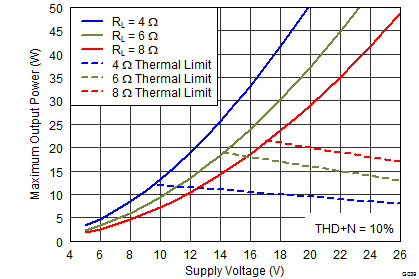
Thermal Limits are referenced to TAS5760xxEVM Rev D
Figure 15. Output Power vs PVDD 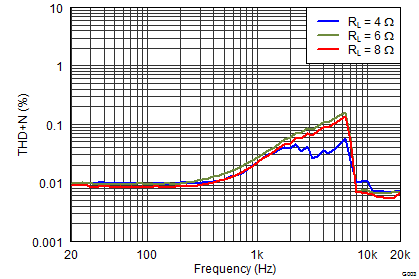
PVDD = 24 V, POSPK = 1 W
Figure 17. THD+N vs Frequency 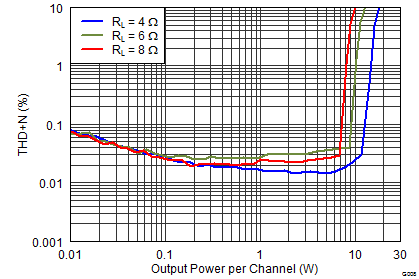
PVDD = 12 V, Both Channels Driven
Figure 19. THD+N vs Output Power 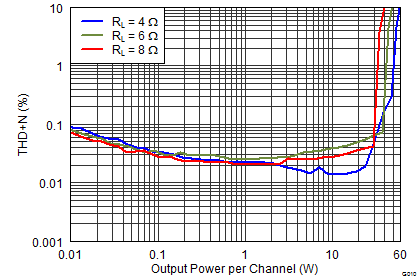
PVDD = 24 V, Both Channels Driven
Figure 21. THD+N vs Output Power 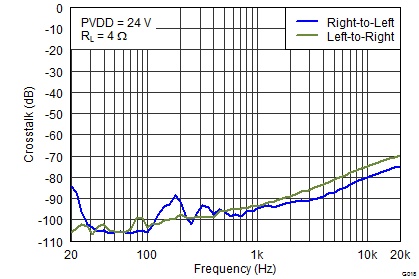 Figure 23. Crosstalk vs Frequency
Figure 23. Crosstalk vs Frequency 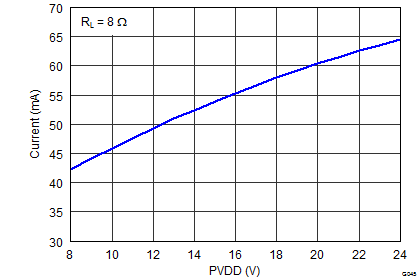 Figure 25. Idle Current Draw vs PVDD (Filterless)
Figure 25. Idle Current Draw vs PVDD (Filterless) 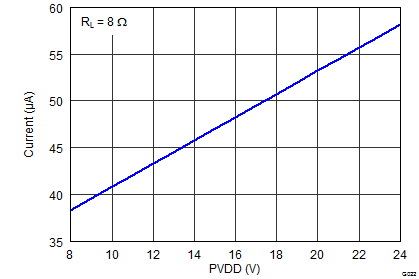 Figure 27. Shutdown Current Draw vs PVDD (Filterless)
Figure 27. Shutdown Current Draw vs PVDD (Filterless) 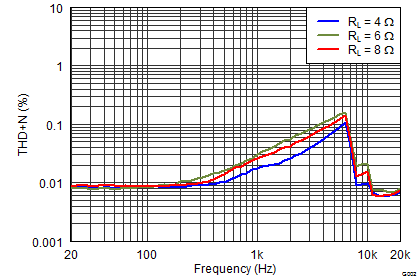
PVDD = 12 V, POSPK = 1 W
Figure 16. THD+N vs Frequency 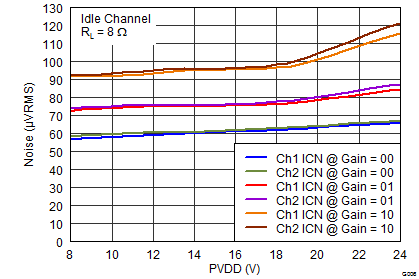 Figure 18. Idle Channel Noise vs PVDD
Figure 18. Idle Channel Noise vs PVDD 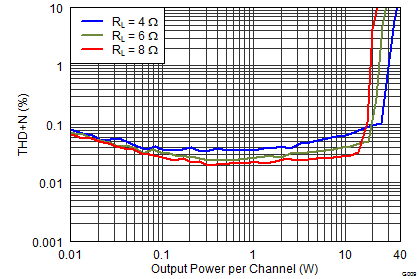
PVDD = 18 V, Both Channels Driven
Figure 20. THD+N vs Output Power 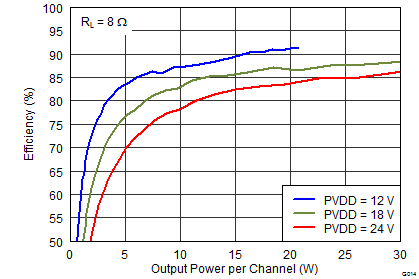 Figure 22. Efficiency vs Output Power
Figure 22. Efficiency vs Output Power 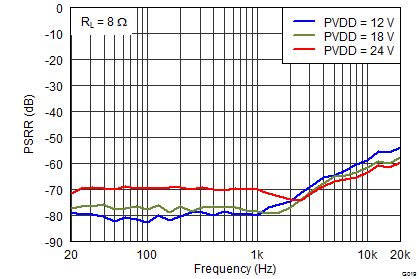 Figure 24. PVDD PSRR vs Frequency
Figure 24. PVDD PSRR vs Frequency 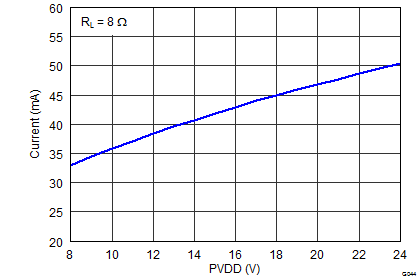
With LC Filter as Shown on EVM
Figure 26. Idle Current Draw vs PVDD